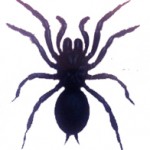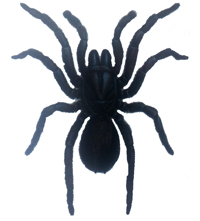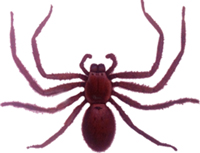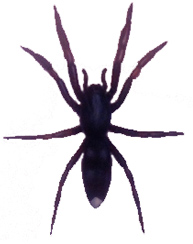Spiders
Most arachnids are nocturnal. When the light fades, spiders become more active. They leave the protection of their burrows or shelter and go in search of food. In the case of web spinning spiders, they construct their web in order to trap prey. As day breaks they seek shelter again.
We have many species of spiders that inhabit our homes and gardens but only a few are of concern, although if you don’t like spiders, many are quite scary and confronting. Cannibalism is well established among spiders. When food is short, spiders kill and eat one another. So if you don’t like big spiders, it is wise to exterminate the smaller ones around the house.
If you ever get bitten by a spider and are unsure, it helps if you can catch it.
 Sydney Funnelweb
Sydney Funnelweb
The most dangerous of our spiders. A ground dwelling spider that normally burrows around trees where its moist and dark. They are most active during late summer and autumn. After heavy rain, they are often mobile as their burrows fill with water or when they are in search of a mate. They are often aggressive when encountered or threatened and rear up. During summer months they are often found at the bottom of swimming pools, so its wise to check before the kids go for a swim.
The female is larger than the male and their venom is very toxic.
Bite Symptoms:
- Pain in the area of bite
- Nausea and vomiting
- Frothing at the mouth
- Delirious, twitching muscles
- Numbness
- Profuse sweating and collapse
- Cramps and pain in lower body
- Coma
Call an ambulance immediately.

Redback
Not a very aggressive spider. Black with a red stripe on a bulbous abdomen. Male much smaller and insignificant. They are generally found in back yards, under furniture, kids toys, under fences, behind pipes and around vents. Not limited to these. They have distinct webbing with all types of garden waste attached to it.
The female bite can be very toxic and painful.
Bite Symptoms:
- Stinging in area of bite
- Stiffness around bite area
- Sweating, nausea and vomiting
- Swelling pain and tenderness
- Pain in lower limbs
- Some cases paralysis
Whitetail
A grey to black spider with a white mark at the bottom of a cigar shaped abdomen. Found under tree bark but often wonder indoors in search of smaller spiders. Bites cause local pain and blistering and also tissue necrosis.
Other Spiders
Although scary to some, these spiders are beneficial in gardens in keeping other bugs like cockroaches and mosquitoes at bay.

Trapdoor Spider: Often mistaken for a funnel web. Not toxic, bite is painful.

Mouse Spider: Enlarged fangs, black with reddish hairs. Females live in holes. Not aggressive. Toxic. Fangs are strong and bite may be painful.

Wolf Spider: Not aggressive. Moves rapidly when disturbed. Bite may be painful for a short while.

Black House Spider: Smaller black non aggressive spider. Often found around windows, in fences and under eaves. Can bite, causing pain, nausea and sweating. Not fatal.

Huntsman: Flattened large and hairy spider. First two pairs of legs bigger than the rear legs. Lives under bark and tight spaces in the day and emerges at night. Feeds on smaller spiders and bugs. Not aggressive, fast moving and not toxic. Bites are rare.
Orb Weaving Spiders: Include -
Garden Orb
Leaf curling
St Andrews Cross
Golden Orb
These spiders are not aggressive and are not toxic. They seldom bite. They spin big webs often from tree to tree or from tree to house. They are beneficial in the garden.

